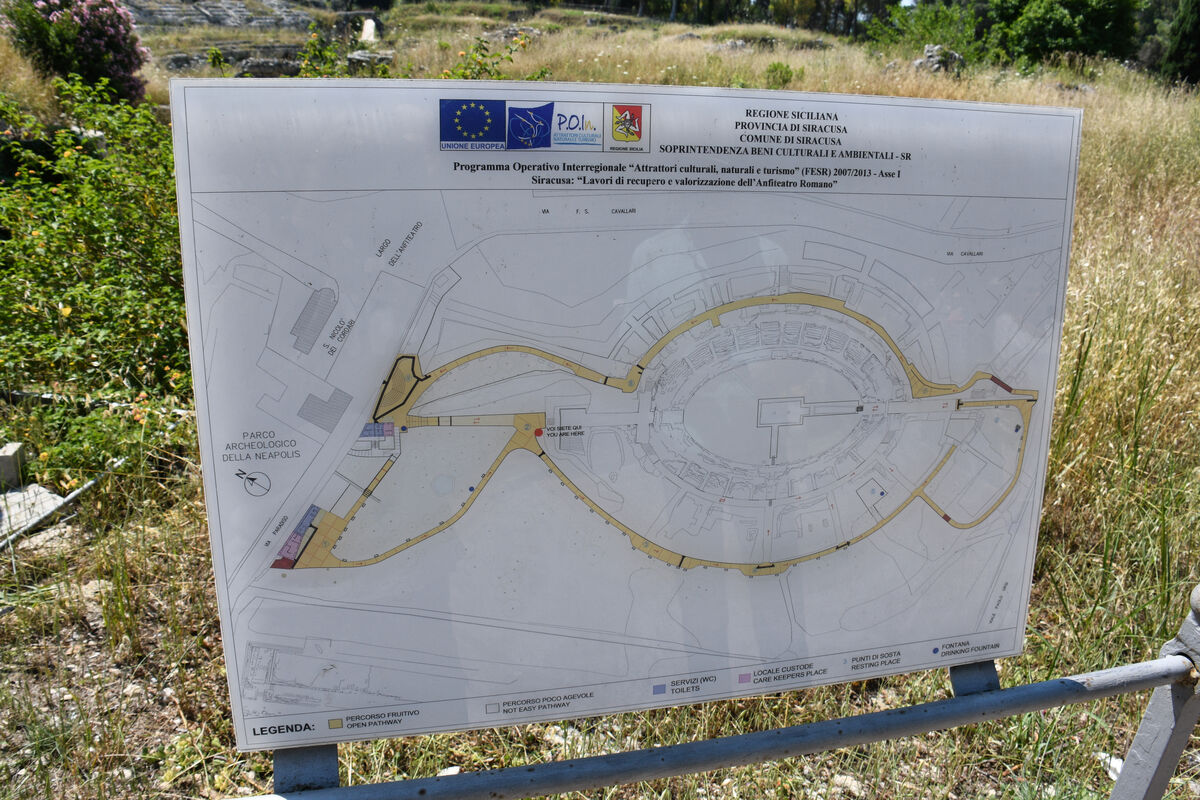Sicily: Siracusa Part 4 - The Roman Amphitheater
Feb 21, 2024 14:19:56 #
A short walk down from the Greek Theater in the Neapolis Architectural Park is the Roman Amphitheater.
The Roman amphitheatre of Syracuse is one of the best preserved structures in the city of Syracuse, Sicily, from the early Imperial period.
Location
The amphitheatre is located in the ancient suburb of Neapolis, in what is now an archaeological park, near the Greek theatre and the Altar of Hieron. The amphitheatre is on a different orientation to these other structures and probably follows the lines of an urban plan developed in the late classical period, which is reflected by the street discovered near the Sanctuary of Demeter in the suburb of Achradina. The main road from Achradina to Neapolis led up to the amphitheatre through an Augustan period triumphal arch , whose foundations are still in situ. Between the arch and the amphitheatre, there was a monumental fountain, fed by a large cistern which has not yet been identified. A separate cistern provided water to the amphitheatre itself; it is preserved under the nearby church of San Nicola.
Description
The amphitheatre is largely excavated out of the living rock and in the north east it takes advantage of the slope of the same rocky outcrop which the Greek theatre is built into. Almost nothing of the superstructure, which was built from masonry, survives.
The structure has monumental dimensions, measuring around 140 metres in length and 119 metres in width.
There were two entrances and a complicated system of steps which led from the upper levels to the exterior. At the centre of the arena there was a rectangular pit, which was originally covered. An underground passage ran from this pit to the entrance at the southern end of the amphitheatre. This pit and passage were necessary for machinery used during the shows. The seating in the cavea is separated from the arena itself by a high platform, under which was a vaulted corridor through which gladiators entered the arena. Above this were the front seats, which were reserved for high ranking individuals. The inscriptions carved on the blocks of the railing were edited by Gentili and seem to have been intended to indicate the different seating areas.
Higher up, there are another two covered walkways running around the entire arena under the seating, while a third walkway ran around the top of the monument and may have had a colonnaded portico running around the top of it. From these circular walkways, a series of radial passages allowed access to the various sectors of the cavea.
Four limestone fragments of a monumental inscription still survive from the amphitheatre, which most likely stood above the main entrance at the south end of the arena, according to Gentili. Lugli dates it to the Augustan period, while Golvin gives it a Julio-Claudian date.
The amphitheatre was first excavated in 1839 by Domenico Lo Faso Pietrasanta.
https://en.wikipedia.org/wiki/Roman_amphitheatre_of_Syracuse
A Brief History of The Romans in Sicily:
Sicily, according to Cato, was "the nurse at whose breast the Roman people is fed". Sicily proved to be vital to Rome for a steady supply of grain.
In 264 Rome attacked the Carthaginian in what was to become the First Punic War (264-241 BC)
In 212 BC the last independent state Syracuse was defeated by the Romans
In the middle of the 5th century the Vandals started raiding the coastal towns of Sicily. About 50 years later they took control of the whole island. In 535 AD Sicily became part of the Byzantine empire.
Cicero on Sicily
“Of all foreign nations Sicily was the first who joined herself to the friendship and alliance of the Roman people. She was the first to be called a province; and the provinces are a great ornament to the empire. She was the first who taught our ancestors how glorious a thing it was to rule over foreign nations. She alone has displayed such good faith and such good will towards the Roman people, that the states of that island which have once come into our alliance have never revolted afterwards, but many of them, and those the most illustrious of them, have remained firm to our friendship for ever.”
Cicero, Marcus Tullius. Cicero: Against Verres in Latin + English (SPQR Study Guides Book 4) . Paul Hudson. Kindle Edition.
https://www.wondersofsicily.com/sicily-romans.htm
For additional images of the Archeological Park, please see my previous posts:
https://www.uglyhedgehog.com/t-799740-1.html
https://www.uglyhedgehog.com/t-799893-1.html
https://www.uglyhedgehog.com/t-800136-1.html
I hope you enjoy these!
Mark
The Roman amphitheatre of Syracuse is one of the best preserved structures in the city of Syracuse, Sicily, from the early Imperial period.
Location
The amphitheatre is located in the ancient suburb of Neapolis, in what is now an archaeological park, near the Greek theatre and the Altar of Hieron. The amphitheatre is on a different orientation to these other structures and probably follows the lines of an urban plan developed in the late classical period, which is reflected by the street discovered near the Sanctuary of Demeter in the suburb of Achradina. The main road from Achradina to Neapolis led up to the amphitheatre through an Augustan period triumphal arch , whose foundations are still in situ. Between the arch and the amphitheatre, there was a monumental fountain, fed by a large cistern which has not yet been identified. A separate cistern provided water to the amphitheatre itself; it is preserved under the nearby church of San Nicola.
Description
The amphitheatre is largely excavated out of the living rock and in the north east it takes advantage of the slope of the same rocky outcrop which the Greek theatre is built into. Almost nothing of the superstructure, which was built from masonry, survives.
The structure has monumental dimensions, measuring around 140 metres in length and 119 metres in width.
There were two entrances and a complicated system of steps which led from the upper levels to the exterior. At the centre of the arena there was a rectangular pit, which was originally covered. An underground passage ran from this pit to the entrance at the southern end of the amphitheatre. This pit and passage were necessary for machinery used during the shows. The seating in the cavea is separated from the arena itself by a high platform, under which was a vaulted corridor through which gladiators entered the arena. Above this were the front seats, which were reserved for high ranking individuals. The inscriptions carved on the blocks of the railing were edited by Gentili and seem to have been intended to indicate the different seating areas.
Higher up, there are another two covered walkways running around the entire arena under the seating, while a third walkway ran around the top of the monument and may have had a colonnaded portico running around the top of it. From these circular walkways, a series of radial passages allowed access to the various sectors of the cavea.
Four limestone fragments of a monumental inscription still survive from the amphitheatre, which most likely stood above the main entrance at the south end of the arena, according to Gentili. Lugli dates it to the Augustan period, while Golvin gives it a Julio-Claudian date.
The amphitheatre was first excavated in 1839 by Domenico Lo Faso Pietrasanta.
https://en.wikipedia.org/wiki/Roman_amphitheatre_of_Syracuse
A Brief History of The Romans in Sicily:
Sicily, according to Cato, was "the nurse at whose breast the Roman people is fed". Sicily proved to be vital to Rome for a steady supply of grain.
In 264 Rome attacked the Carthaginian in what was to become the First Punic War (264-241 BC)
In 212 BC the last independent state Syracuse was defeated by the Romans
In the middle of the 5th century the Vandals started raiding the coastal towns of Sicily. About 50 years later they took control of the whole island. In 535 AD Sicily became part of the Byzantine empire.
Cicero on Sicily
“Of all foreign nations Sicily was the first who joined herself to the friendship and alliance of the Roman people. She was the first to be called a province; and the provinces are a great ornament to the empire. She was the first who taught our ancestors how glorious a thing it was to rule over foreign nations. She alone has displayed such good faith and such good will towards the Roman people, that the states of that island which have once come into our alliance have never revolted afterwards, but many of them, and those the most illustrious of them, have remained firm to our friendship for ever.”
Cicero, Marcus Tullius. Cicero: Against Verres in Latin + English (SPQR Study Guides Book 4) . Paul Hudson. Kindle Edition.
https://www.wondersofsicily.com/sicily-romans.htm
For additional images of the Archeological Park, please see my previous posts:
https://www.uglyhedgehog.com/t-799740-1.html
https://www.uglyhedgehog.com/t-799893-1.html
https://www.uglyhedgehog.com/t-800136-1.html
I hope you enjoy these!
Mark
Gail in front of the amphitheater ruins
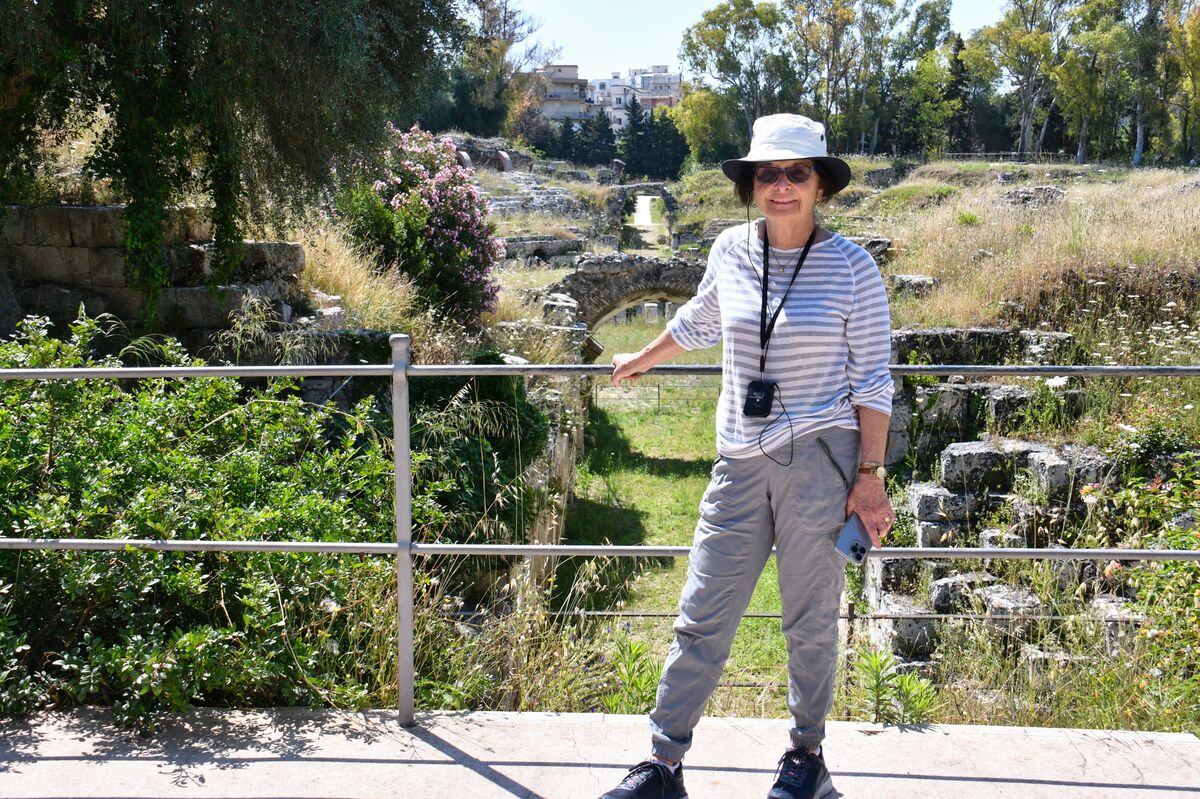
(Download)
Ara Di Ierone - The largest Greek alter in the world designed by Hieron II in the 3rd Century BC. Almost nothing except the foundations of the structure survive today. At its base it is 199.07 metres long and 22.51 metres wide
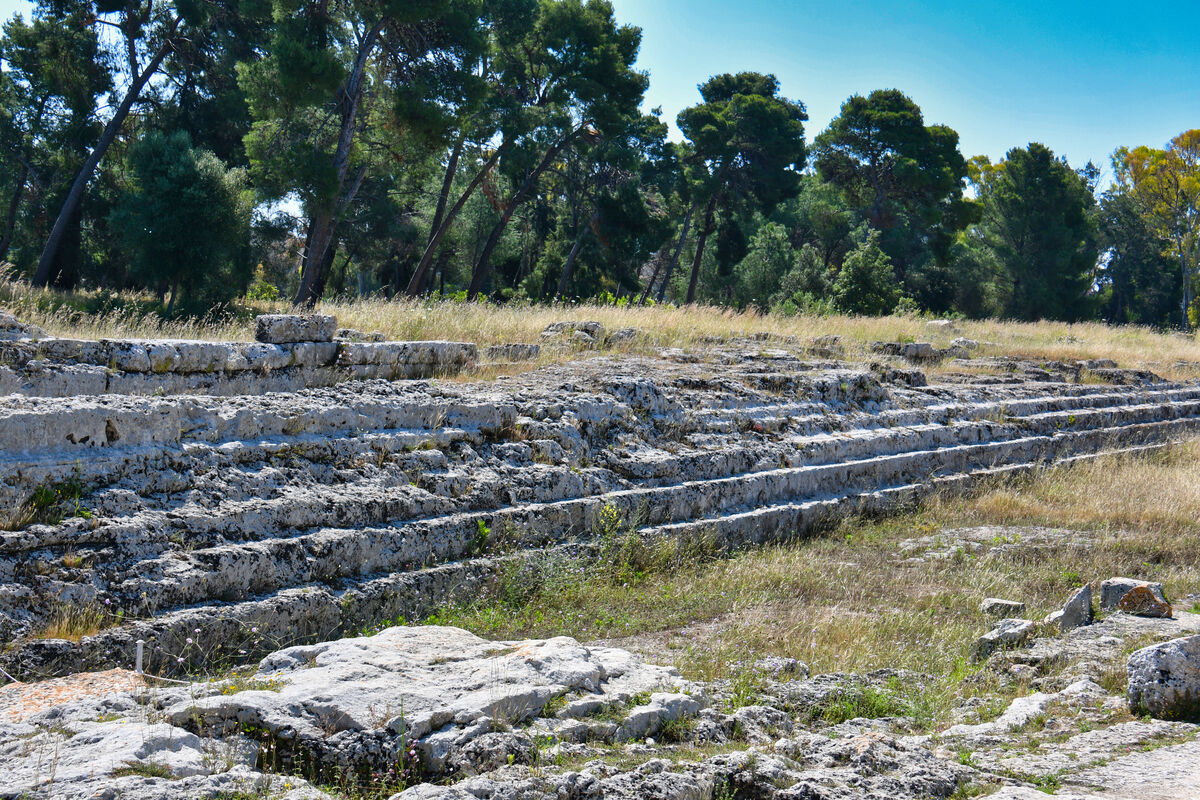
(Download)
It made at the same time as the third phase of the nearby Greek theatre, after 235 BC. The votive deposits found in the grotto show it was a sacred site in the Archaic period, not long after the city of Syracuse was established.
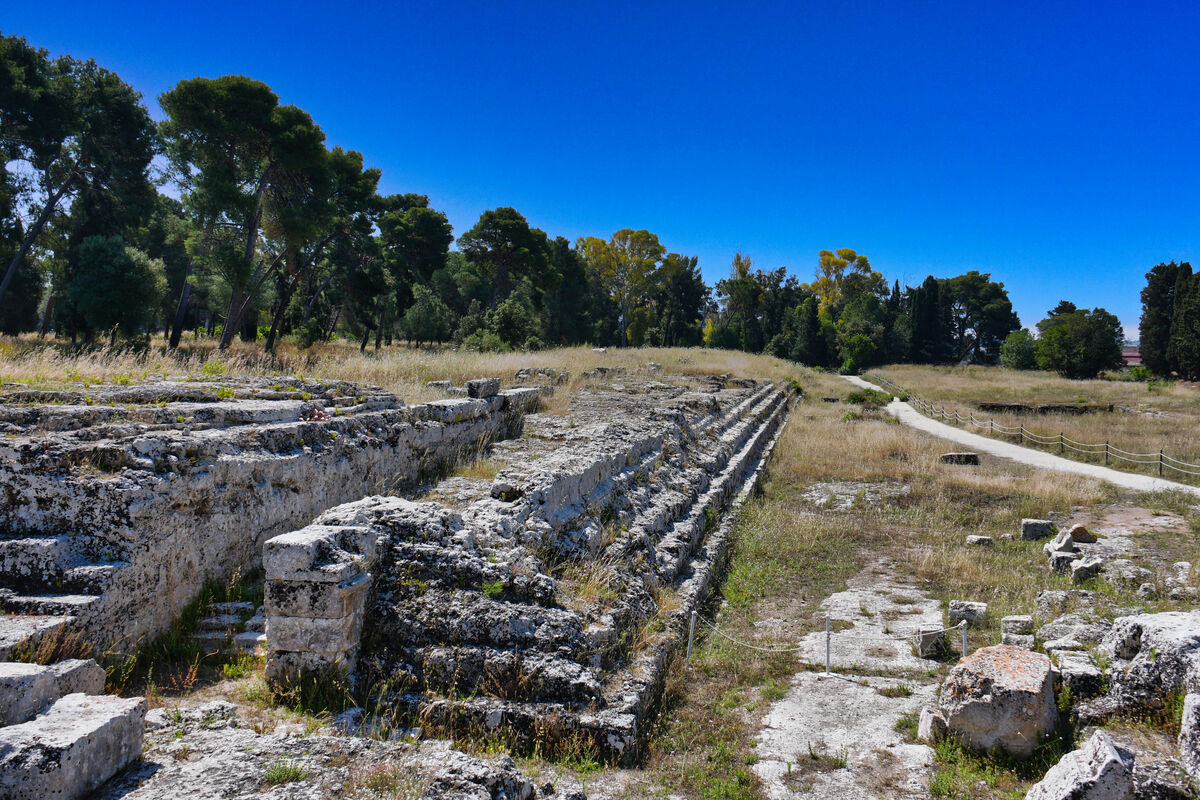
(Download)
The Roman amphitheatre in Siracusa (140m by 119m). It was used by gladiator fights with wild beasts. The rectangular depression was probably for the machinery used in the spectacles.
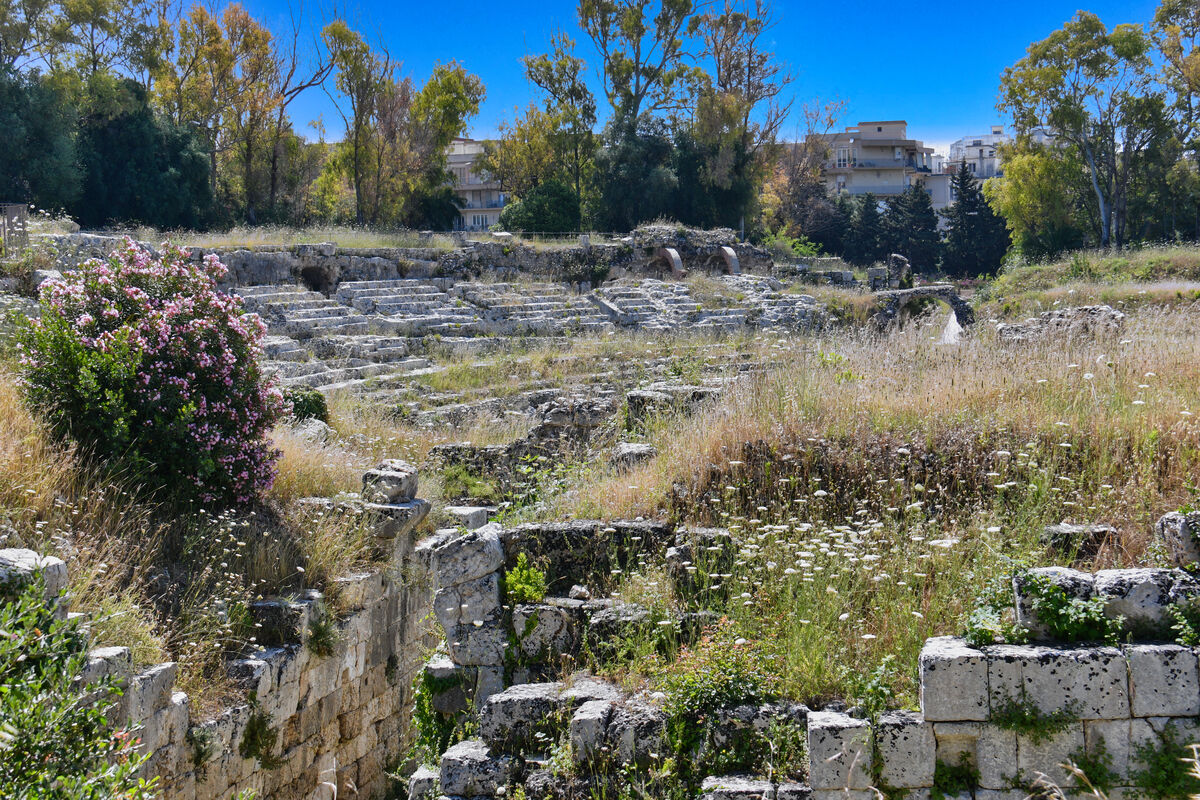
(Download)
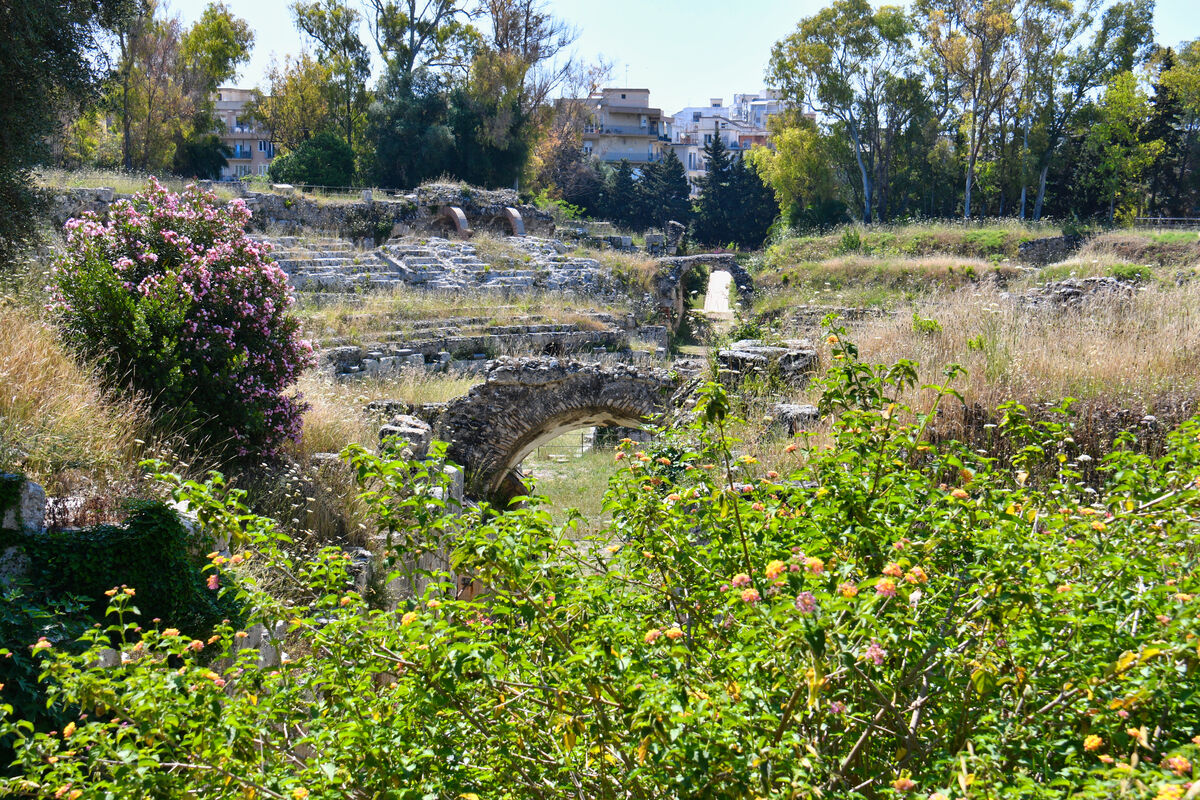
(Download)

(Download)
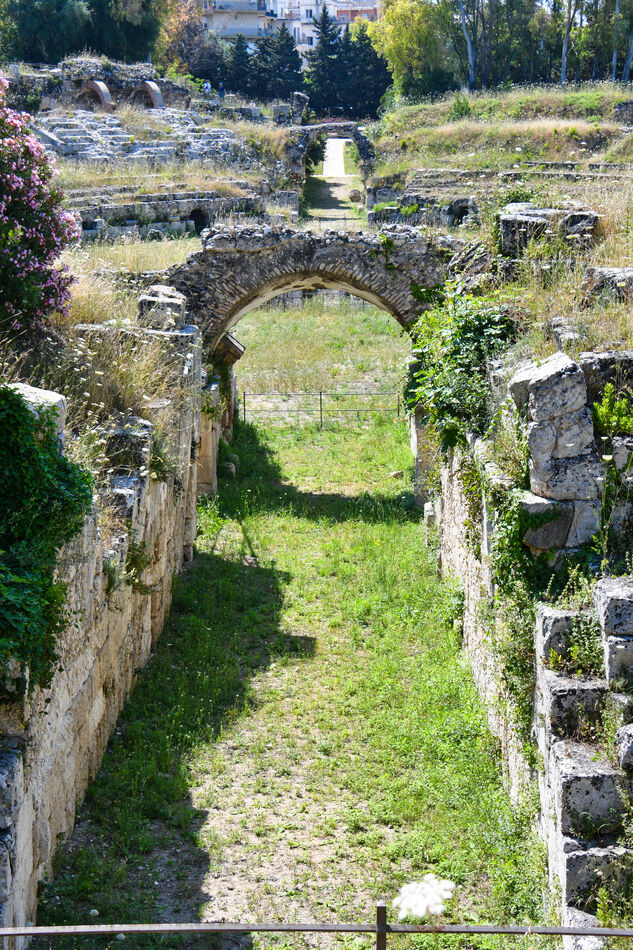
(Download)

(Download)

(Download)
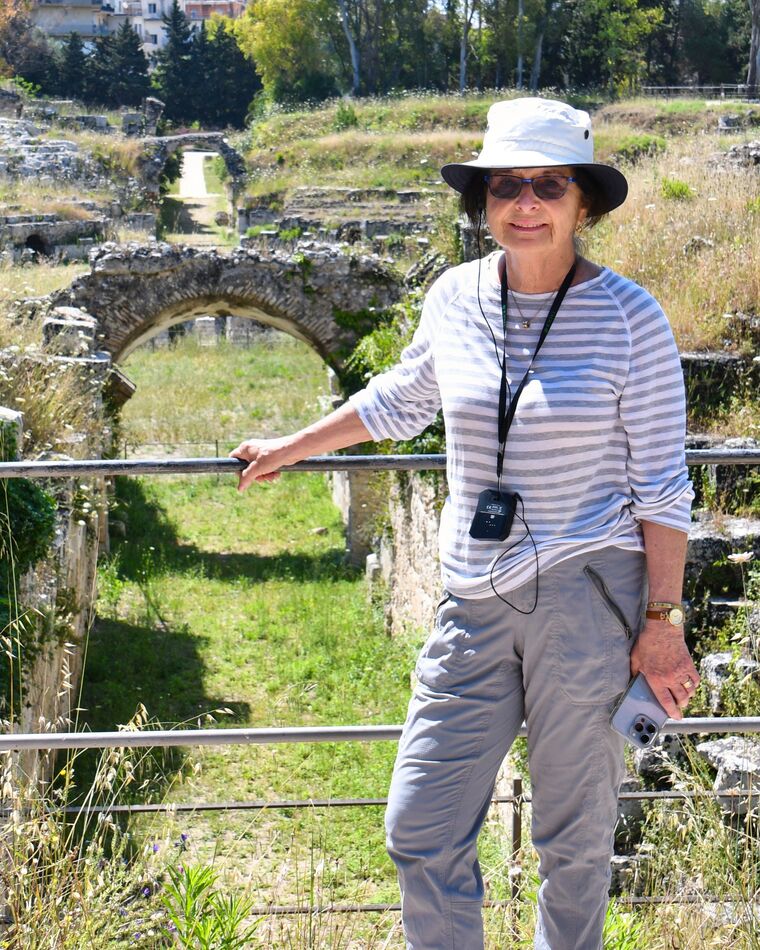
(Download)
Feb 21, 2024 14:21:44 #
Feb 21, 2024 14:38:31 #
Feb 21, 2024 14:40:56 #
Feb 21, 2024 14:45:24 #
Feb 21, 2024 15:13:07 #
Feb 21, 2024 15:56:07 #
Feb 21, 2024 16:16:37 #
Feb 21, 2024 16:42:53 #
srfmhg wrote:
A short walk down from the Greek Theater in the Ne... (show quote)
Thousands of years old, yet still full of atmosphere and character which, I think, we are sorely lacking in many of our cities today

 Thanks for posting these great shots, Mark
Thanks for posting these great shots, Mark 


Feb 21, 2024 17:19:49 #
Feb 21, 2024 19:15:56 #
Feb 21, 2024 19:16:18 #
Feb 21, 2024 19:16:45 #
Feb 21, 2024 19:17:09 #
Feb 21, 2024 19:20:01 #
joecichjr wrote:
Thousands of years old, yet still full of atmosphe... (show quote)
You're most welcome Joe. Thank you for your always generous comments. It's amazing to be there and imagine you're watching a spectacle that took place on that spot 2300 years ago!
If you want to reply, then register here. Registration is free and your account is created instantly, so you can post right away.

